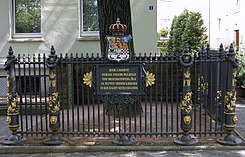Petritorwall
| Petritorwall | |
|---|---|
| Street in Braunschweig | |
| Lattice of the Friedrich Wilhelm Oak | |
| Basic data | |
| place | Braunschweig |
| District | Downtown |
| Connecting roads | Hohetorwall , Inselwall |
| Cross streets | Celler Strasse, Am Alten Petritore, Am Neuen Petritore |
| use | |
| User groups | Pedestrian traffic , bicycle traffic , car traffic , public transport |
The Petritorwall is a street in the city center of Braunschweig . The street was built at the beginning of the 19th century as part of the wall promenade around Braunschweig's old town. The course or the street area of the Petritorwall is listed. The northern part of the Petritorwall widens to a plaza-like street between the streets “Am Alten Petritore” and “Am Neuen Petritore”. Before the destruction of the Second World War , the street there began traffic between Celler Strasse and Radeklint in the old town. It was named after the former Petritor , one of the medieval city gates, and was formerly called Petrithor-Promenade.
In the north the road merges into the Inselwall and in the south into the Hohetorwall.
history
From 1803 the fortress of Braunschweig was removed and redesigned under the direction of the architect Peter Joseph Krahe (1758–1840). Promenades were built on the former ramparts. Initially, gardens with garden houses were built on the promenades, and villas were gradually built over the course of the 19th century.
At the beginning of the 19th century, the river bath of Mr. Kaulitz was on Petritorwall in the western flood ditch. In 1863 gas lanterns were introduced on the wall. At Petritorwall, the garden company once owned a two-acre garden. The company existed since 1831 and was founded by the banker Carl Dietrich Löbbecke. After the Petritorwall was further built at the turn of the century, the company's property had to be given up. The villa at Petritorwall 26 was built in 1868. Today's monument was built according to plans by the architect Friedrich Lilly (1835–1906) in the classical style.
For the Waterloo commemoration on June 18, 1850, an oak (later named Friedrich Wilhelm oak) was planted. On August 1, 1961, the oak was inaugurated in memory of Duke Friedrich Wilhelm's passage through Braunschweig in 1809.
The property at Petritorwall 30 was acquired in 1923 by the Jewish Scheyer family. After the Scheyers tried unsuccessfully to sell the property during the National Socialist era and fled Germany in 1939, the house and property were Aryanized . After the war, the Scheyers applied for a return transfer of the house and property, which was carried out in 1950.
During the second air raid on Braunschweig by British airmen on February 10 and 11, 1941, the Petritorwall was hit by several incendiary bombs. Individual roof trusses caught fire and could be quickly extinguished. During the ninth air raid on February 10, 1944, the Petritorwall was hit again. The newly built Emmaus Chapel at Petritorwall 11 was consecrated on October 20, 1946. It was built by the free church "Evangelical Community".
On July 25, 1963, the road breakthrough from Celler Strasse and Petritorwall to Radeklint was cleared. This was initially named "Am Petritore", later the street was incorporated into Celler Straße.
From 2009 to 2011 the renovation and renovation of the villa on Petritorwall 12 took place. The building, whose facade is listed, fell into ruin for a long time. The villa with a clinker stone facade was built in 1882. Contrary to earlier statements, the interior walls were not left standing and the entire building was gutted. A new residential building was also built on the Petritorwall 14 property. Among other things, this new building and other planned investments led to controversies about the development on Wallring. The cityscape of the ramparts was seen threatened and lively discussions about the future design of the ramparts began. And the city administration announced an amendment to the development plan, which came from 1939.
literature
- Jürgen Hodemacher: Braunschweig's streets - their names and their stories. Volume 1: Inner City. Elm-Verlag, Cremlingen 1995, ISBN 3-927-06011-9 .
Web links
Individual evidence
- ↑ a b City Chronicle Braunschweig on braunschweig.de
- ↑ Stolpersteine for Braunschweig: Paul and Paula Scheyer on stolpersteine-fuer-braunschweig.de
- ↑ Braunschweiger Zeitung: Dilapidated villa on Petritorwall becomes a gem of March 13, 2008 again.
- ↑ Braunschweiger Zeitung: Residents: Newly built villas do not fit into the image of the ramparts from May 4, 2009
Coordinates: 52 ° 15 '58.6 " N , 10 ° 30' 42.7" E


